The 3D printer resin is prepared with various chemicals and a layer of hydrogel with microbes sprayed on it. These living organisms respond to the chemical signals by displaying specific colors or fluorescence.
With this 3D printing platform, three to seven different resins can be used with different properties in all conceivable mixing ratios. In combination with synthetic biological engineering, it is possible to design objects with biological surfaces that can be programmed to respond to stimuli in specific ways. In addition to chemical signals, these may also include light or temperature changes.
Medical applications
The material properties of the printed object can be accurately and continuously varied between different parts of the structure, some sections being stiffer and others more flexible, and some more absorbent and others liquid-repellent. Such variations may be useful in biomedical applications that provide strength and support, but must also be sufficiently soft and pliable to be comfortable in places where they are in contact with the body.
The technology can also be used for smart packaging that detects contamination or even for environmentally-friendly architectural skins, which respond to the environment and adapt in real time.



